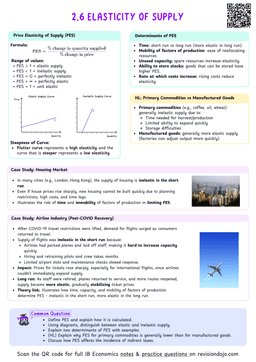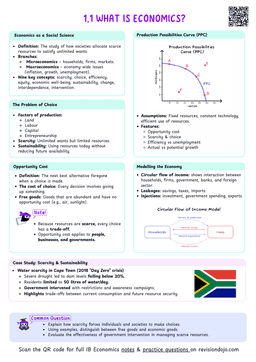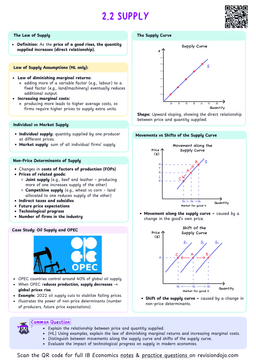- The Price Level (PL) of an economy is not the only factor that affects its short-run aggregate supply (SRAS).
- While changes in the PL cause movements along the SRAS curve, changes in the determinants of short-run aggregate supply shift the SRAS curve.
Determinants of short-run aggregate supply
Factors that shift the SRAS curve.
The determinants of SRAS covered in the IB curriculum are:
- Costs of factors of production.
- Indirect taxes.
The most important thing to note in this topic is that:
- Changes in price level cause changes the quantity of real GDP produced (causing a movement along the SRAS curve).
- Changes in the determinants of SRAS lead to changes in the quantity of real GDP produced at all possible price levels (causing a shift of the SRAS curve).
- A rightward shift indicates that at all given price levels, the total quantity of real GDP produced increases.
- A leftward shift indicates that at all given price levels, the total quantity of real GDP produced decreases.
In IB Economics long-answer questions, it is very important to explain processes step-by-step, without skipping any steps.
In this section, the effect of changes in the determinants of SRAS will be explained in such way.
Costs of factors of production
Increase in the costs of factors of production → leftward shift in SRAS
- Factors of production refer to the resources used in the production process (land, labour, capital, entrepreneurship).
- If the costs of these factors increase (higher wages, rising raw material prices...), production becomes more expensive for firms.
- As a result, to maintain profit margins, firms across the economy decrease their production at all possible price levels.
- Since short-run aggregate supply (SRAS) reflects the total output (real GDP) firms produce at different price levels...
- An increase in production costs reduces SRAS at all price levels, and shifts the SRAS curve to the left (SRAS1→SRAS2).
Decrease in the costs of factors of production → rightward shift in SRAS
- Factors of production refer to the resources used in the production process (land, labour, capital, entrepreneurship).
- If the costs of these factors decrease (lower wages, falling raw material prices...), production becomes cheaper for firms.
- As a result, seeking greater profit margins, firms across the economy increase their production at all possible price levels.
- Since short-run aggregate supply (SRAS) reflects the total output (real GDP) firms produce at different price levels...
- A decrease in production costs increases SRAS at all price levels, and shifts the SRAS curve to the right (SRAS1→SRAS2).
Indirect taxes
Indirect taxes
Taxes levied on spending on goods and services. They are called indirect because while consumers contribute to part or all of the tax, it is the suppliers (firms) who collect and transfer these taxes to the government authorities (consumers pay the taxes indirectly).
Increase in indirect taxes → leftward shift in SRAS
- When indirect taxes increase, firms face higher costs for producing goods and services, as they are responsible for paying these taxes to the government.
- Facing higher production costs, in order to maintain profit margins, firms across the economy decrease their production at all possible price levels.
- Since short-run aggregate supply (SRAS) reflects the total output (real GDP) firms produce at different price levels...
- An increase in indirect taxes decreases SRAS at all price levels, and shifts the SRAS curve to the left (SRAS1→SRAS2).
Decrease in indirect taxes → rightward shift in SRAS
- When indirect taxes decrease, firms face lower costs for producing goods and services, as they are responsible for paying these taxes to the government.
- Facing lower production costs, seeking greater profit margins, firms across the economy increase their production at all possible price levels.
- Since short-run aggregate supply (SRAS) reflects the total output (real GDP) firms produce at different price levels...
- A decrease in indirect taxes increases SRAS at all price levels, and shifts the SRAS curve to the right (SRAS1→SRAS2).
Go over all the determinants of SRAS and try to explain their effect on the SRAS and the SRAS curve step-by-step.
If you master this, Paper 1 will become much easier!


